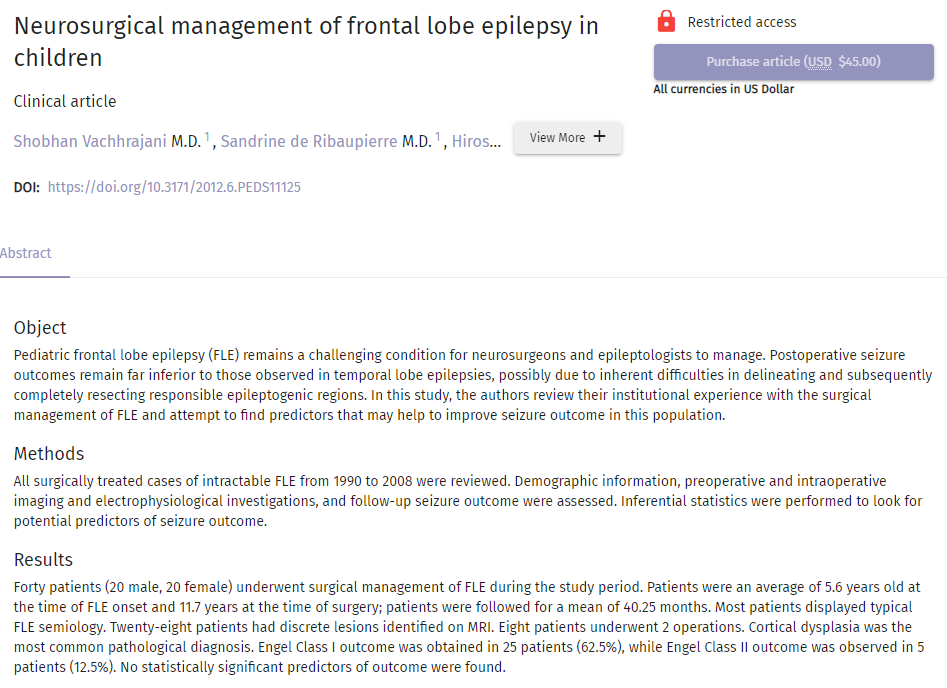Neurosurgical management of frontal lobe epilepsy in children(儿童额叶癫痫的神经外科治疗)
英文原文摘要
Pediatric frontal lobe epilepsy (FLE) remains a challenging condition for neurosurgeons and epileptologists to manage. Postoperative seizure outcomes remain far inferior to those observed in temporal lobe epilepsies, possibly due to inherent difficulties in delineating and subsequently completely resecting responsible epileptogenic regions. In this study, the authors review their institutional experience with the surgical management of FLE and attempt to find predictors that may help to improve seizure outcome in this population.
Methods
All surgically treated cases of intractable FLE from 1990 to 2008 were reviewed. Demographic information, preoperative and intraoperative imaging and electrophysiological investigations, and follow-up seizure outcome were assessed. Inferential statistics were performed to look for potential predictors of seizure outcome.
Results
Forty patients (20 male, 20 female) underwent surgical management of FLE during the study period. Patients were an average of 5.6 years old at the time of FLE onset and 11.7 years at the time of surgery; patients were followed for a mean of 40.25 months. Most patients displayed typical FLE semiology. Twenty-eight patients had discrete lesions identified on MRI. Eight patients underwent 2 operations. Cortical dysplasia was the most common pathological diagnosis. Engel Class I outcome was obtained in 25 patients (62.5%), while Engel Class II outcome was observed in 5 patients (12.5%). No statistically significant predictors of outcome were found.
Conclusions
Control of FLE remains a challenging problem. Favorable seizure outcome, obtained in 62% of patients in this series, is still not as easily obtained in FLE as it is in temporal lobe epilepsy. While no statistically significant predictors of seizure outcome were revealed in this study, patients with FLE continue to require extensive workup and investigation to arrive at a logical and comprehensive neurosurgical treatment plan. Future studies with improved neuroimaging and advanced invasive monitoring strategies may well help define factors for success in this form of epilepsy that is difficult to control.
中文摘要
小儿额叶癫痫(FLE)仍然是神经外科医师和癫痫学家应对的挑战性条件。术后癫痫发作的结果仍然远不如颞叶癫痫中观察到的结果,可能是由于在划定并随后完全切除负责的癫痫发生区域时固有的困难。在这项研究中,作者回顾了他们在FLE外科手术治疗方面的机构经验,并试图找到可能有助于好转该人群癫痫发作结果的评估因子。
方法:回顾性分析了1990年至2008年全部经手术治疗的顽固性FLE病例。人口统计学信息,术前和术中成像和电生理检查,以及癫痫发作的随访结果进行了评估。进行推断统计以寻找癫痫发作结果的潜在评估因子。
结果:在研究期间,对40例患者(男性20例,女性20例)进行了FLE的外科治疗。患者在FLE发作时平均为5.6岁,在手术时平均为11.7岁。平均随访40.25个月。大多数患者表现出典型的FLE符号学。28名患者在MRI上发现了离散的病灶。8例患者接受了2次手术。皮质发育异常是较常见的病理诊断。25位患者(62.5%)获得了恩格尔I类结局,而5位患者(12.5%)获得了恩格尔II类结局。未发现有统计学意义的预后指标。
结论:控制FLE仍然是一个具有挑战性的问题。在该系列患者中,有62%的患者获得了良好的癫痫发作结局,但在FLE中仍不如在颞叶癫痫中容易获得。尽管在这项研究中没有发现癫痫发作结局的统计学显着评估因素,但FLE患者继续需要进行广泛的检查和检查,才能得出合理而多方位的神经外科治疗计划。未来有改进的神经影像学和前沿的侵入性监测策略的研究可能很好地帮助定义这种难以控制的癫痫病形式成功的因素。

该论文的作者之一为来自INC国际神经外科医生集团旗下国际神经外科顾问团的James T. Rutka教授,他目前是加拿大多伦多大学儿童医院SickKids的神经外科教授以及大外科主任。对于儿童癫痫,
James T. Rutka教授认为:大约10%到20%的癫痫儿童都是癫痫手术的候选者,幸运的是,在多伦多大学儿童医院SickKids,我们有一个庞大的团队正在帮助我们确定哪些儿童会从癫痫手术中受益。所以我们有神经外科医生,我们有神经内科医生,我们有神经心理学家,有神经放射科医生,我们会全部人一起确定癫痫儿童的更佳治疗方案。而且,如前所述,至少20%的儿童可以成为外科手术的候选者。患有难治性癫痫的儿童可以通过现在多伦多SickKids使用的外科技术而得到治愈。
James T. Rutka教授是国际上享誉盛名的儿科神经外科医生之一。他是亚瑟和索尼亚拉巴特脑肿瘤研究中心的主任,该研究中心是国际上规模较大的儿科脑肿瘤研究中心之一。他除了在脑肿瘤方面的知识外,对于脑血管畸形疾病同样有丰富的研究和临床经验。

除此之外,教授所在的多伦多大学附属儿童医院(Sickkids)迎合了顽固性癫痫患儿的个人学习和社交情感需求,为癫痫患儿配置不同教育教师、儿科医生、神经心理学家和社会工作者,以更好地了解癫痫与每个学生的学习情况和社会情感需求之间的相互作用,以及尽可能地提供国际前沿的医疗治疗。




